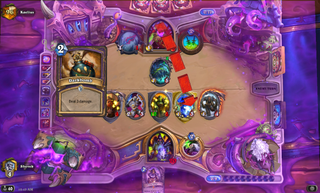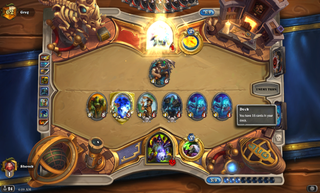
I’m more excited about Hearthstone than I have been since the beta. The arrival of the Standard format has provided a broad new canvas for savvy deckbuilders to create their masterpieces on, and with it Hearthstone finally feels like a grown-up CCG. Secret Paladin, along with other oppressive decks from the previous era, has been banished to Wild. For most players, sick of the ubiquitous Sludge Belchers and Piloted Shredders, the split couldn’t come soon enough. Which begs the question, who’s actually playing Wild, and how crazy is it in there? To find out, PC Gamer ordered me to play 125 games on the Wild ladder. This is my terrifying story.
As soon as you toggle from Standard to Wild, the lighting goes dark and unruly vines spread across the background artwork. Clearly, Blizzard want you to know that you’re in for a rough ride. The spooky atmosphere proved appropriate for my first game as I queued straight into a Paladin. Turn 1: Zombie Chow. Turn 2: Shielded Mini-bot. Turn 3: Muster for Battle. Turn 4: Piloted Shredder. Turn 5: Sludge Belcher. Turn 6: Mysterious Challenger. Turn 7: Dr. Boom. I contemplated the grotesque perfection of his curve as I hit concede.
I wasn’t surprised by what I found in the badlands of Wild. Up to rank 12 or so, you will encounter a mix of players doing daily quests or relaxing with familiar decks—Zoo Warlock, Secret Paladin, Aggro Shaman, Tempo Mage—and some mavericks testing out their latest homebrew decks. It feels like a better version of Casual mode, and I get the sense that most players dabble in Wild for a few games here and there, without bothering to climb ranks. On my second game in Wild, my opponent played Wild Growth into Astral Communion. I conceded after the turn 4 Ysera.

Progressing up through the intermediate ranks, the experimental decks soon disappeared. In amongst the fast tempo decks I started to see Patron Warriors and Freeze Mages. By the time I breached rank 5, Wild felt like a ghost town. In the space of a few games, I’d be matched against anyone from rank 7 to top 100 Legend. Regularly, I faced the same player two or three times in a row, despite queue times in excess of 30 seconds. I began to remember the decks of players that I had already faced four, five, or six times during my grind—like the Reno Freeze Mage player that BMed me two games in a row, and the Anyfin Paladin who also ran Ragnaros, Lightlord. This season I was the only person on my friends list with a higher rank in Wild than Standard. Throughout my climb to Legend, I didn’t see anyone ranked higher than 150 Legend on Wild. I suspect that by season’s end there won’t be more than 200 Wild Legends on NA.
By rotating cards out of Standard, Blizzard can print new ones that would have created broken combos. Sooner or later, that will lead to some radical new power decks in Wild. Are we there yet? I don’t think so. Most of what I faced would have been recognizable before Whispers of the Old God arrived: Secret Paladin, Zoo, Tempo Mage, Control Priest, Patron Warrior. Virtually everything else seemed like a familiar Standard deck, only with the addition of the ubiquitous Shredders, Belchers—and of course Dr. Boom. Even the most innovative decks I faced were adaptations from Standard: stuff like C’Thun Warlock or Yogg-Saron Hunter. Some players didn’t even seem to have adapted their decks at all. If Old Gods introduced some extreme synergy in Wild that wasn’t possible before, I didn’t see anyone taking advantage of it yet.

The closest thing I managed to a truly broken Wild-specific combo was Ancestor’s Call + Y’Shaarj. Getting a turn four 10/10 that summons a free Sylvanas Windrunner or Soggoth the Slitherer is the sort of spectacular blowout that could potentially dominate Wild, but it feels barely viable to me. I only met one other person trying that deck. To climb efficiently, I took Firebat’s advice and turned to Zoo. Darkshire Councilman is strong in Standard with Forbidden Ritual, and it’s even better in Wild with Imp-losion.
The good news for those curious about Wild is that it isn’t entirely dominated by predictable aggressive decks. I saw twice as many Paladins as any other class, but only half of them were the Secret sort. The rest were Anyfin decks or versions of Control Paladin. Priest and Warrior were just as common as Warlock, Hunter and Shaman. Druid and Rogue are, from what I saw, practically nonexistent in Wild. It actually feels like a pretty balanced format, with a decent selection of Old Gods cards seeing play across a variety of strategies, ranging from bombs like Call of the Wild to unassuming utility cards like Blood to Ichor and Eternal Sentinel. A fair few decks are running Eater of Secrets to counter Secret Paladin, but I’m skeptical of its effectiveness. Ravaging Ghoul, a Warrior staple in both Wild and Standard, proved particularly annoying to my Zoo deck. I also ran into all four Old Gods during my climb toward Wild Legend. (For the curious, you can find the record of my games here and here).
PC Gamer Newsletter
Sign up to get the best content of the week, and great gaming deals, as picked by the editors.
Even for control decks, the format is defined by playing strong minions on curve for the critical early turns.
Standard, ironically, feels “wilder” than Wild right now, since experimental Standard decks can’t fall back on the stale reliability of Shredder and Dr. Boom. This is partly by design, though. The announcement of Standard drew criticism from budget players upset at having their hard-earned Dr. Booms and Loathebs effectively deleted from the main game. Wild was meant to allow them to continue playing with all their cards, undisturbed. I’d say Blizzard succeeded in that goal, since the current Wild meta feels very much like a continuation of Hearthstone as it existed before Standard. If my experience on Wild ladder is any indication, though, very few people actually prefer that meta.
What will it take for Wild to get to the point where it has a distinctive, exciting identity of its own? In a word, speed. If you look at constructed formats across other CCGs, formats that don’t rotate out cards have shorter games; Magic: the Gathering’s Modern, for instance, is called a “turn four format” because so many decks can win within that timeframe. It’s easy to see why: if you can play a game winning combo on turn 4, you will beat decks that can’t play their game winning combo until turn 5. In Wild currently, most of the powerful “cool stuff” doesn’t happen until turn 6 or later. Turn 6 is also about how long it takes an aggressive deck with a decent start to kill you, which means that even for control decks, the format is defined by playing strong minions on curve for the critical early turns.

As more cards are printed, I expect aggro decks to gradually get more efficient, shifting the kill-turn earlier. Wild will feel pretty much the same until we see combos that go off earlier than aggro can win—and which are powerful enough to beat minion-based curve openings. It’s bound to happen eventually, and when it does Wild will stop being as much about who drew Shielded Mini-bot + Muster For Battle, and start being more about single-minded combo decks executing their broken, but totally sweet gameplans.
For now, I can’t see Wild garnering much excitement as either a ladder or tournament format. Standard features most of the basic strategies present in Wild, but with more variety and without game-swinging Boom Bots. As Standard matures and stabilizes, a few more players will probably switch to Wild, but the sheer number of games required to climb to Legend means that very few players will grind both ladders. Now that Wild has done its job providing continuity during the launch of Standard, I expect the next few card sets to be a bit more reckless about breaking Wild. I would imagine that Blizzard doesn’t want Wild to stay a ghost town forever.
Most Popular





